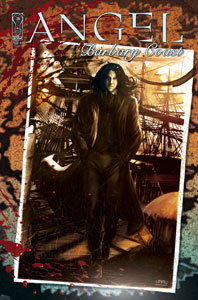The three-issue “Angel: Barbary Coast” (April-June 2010) is part of an unofficial trilogy of IDW comic stories where Angel has a soul but isn’t yet a contemporary hero. This one isn’t as strong as John Byrne’s “Blood & Trenches” and “Angel vs. Frankenstein,” but Byrne sets a high bar, so there’s no shame in that. Thanks to wonderful art by Franco Urru and an evocative portrayal of San Francisco at the time of the 1906 Earthquake, “Angel” fans might want to pick up “Barbary Coast.”
The story and characterizations by Buffyverse newcomer David Tischman are a bit scattershot, and his communication with Urru is sometimes sketchy. In a couple panels, I’m not sure what exactly is going on. I wasn’t horribly lost by any means, but not as engaged as I should’ve been as I tried to figure out everyone’s role. Tischman and Urru start by portraying a corrupt San Francisco that calls to mind New York from a decade earlier as portrayed on TV’s “The Alienist” – a nice place to visit in fiction, but I wouldn’t want to live there (or visit it in a time machine).
Angel seeks a cure for the pain of having a soul, or perhaps he wants the soul removed. But the Chinese mystic Xin jerks him around and uses him to fetch a girl with a dragon tattoo that covers her whole body. On top of this, various demons and demon hunters are on Angel’s tail. He’s not having a fun time, but even though Tischman provides us with Angel’s internal narration, I didn’t feel as connected to the title character’s plight as in Byrne’s work.
In the end, I can’t say these characters are stereotypes. Ling Kai is no damsel in distress; she turns into a dragon the size of a city block, and her fight with Angel takes up a good chunk of “Barbary Coast.” (So when Angel says he wants to fight the dragon at the end of “Not Fade Away” (5.22), perhaps it comes from a place of nostalgia.) In the end, Ling Kai is unappreciative of Angel helping her (she has a soul but acts soulless), which I guess is supposed to make Angel reflect on his own condition.
The folks who are after Angel work for Wolfram & Hart, it turns out. The leader of the little group, Behr, tells the muscle, Bart, on the final panel: “For some reason, the Senior Partners want him alive.” So “Barbary Coast” is the tale where W&H becomes aware of (or seriously interested in) Angel, but it loses something because we don’t know exactly what has inspired W&H to believe Angel can be used to its advantage. This series feels like it’s trying to become an important entry in “Angel” lore, but with none of the characters popping up in future stories, its case becomes tenuous.
Urru’s art, though, elevates the comic. It’s both colorful and dark, and filled with wonderful touches like smoke curling off of Angel’s body in sunlight, and the vampire’s skin beginning to burn like glowing coals. Although Urru’s work is a perfect complement to Brian Lynch’s comedic actioners under the “Spike” banner, it likewise shines alongside Tischman’s straightforward, grim story. Well, it actually outshines it, but if art is at least half the reason to check out a comic book, “Barbary Coast” can’t be dismissed.

Click here for an index of all of John’s “Buffy” and “Angel” reviews.

